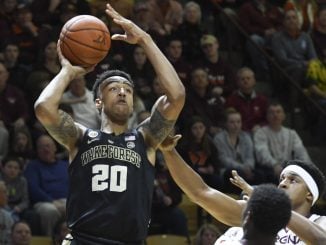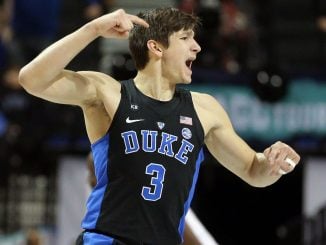
Commenting on the competition his team had to beat to win its NCAA regional last spring, a tournament that also included NC State and Campbell, East Carolina coach Cliff Godwin assessed the quality of college baseball in the Old North State by saying “I don’t know if there’s another state in the country that has the amount of talent” as North Carolina.
It’s an assertion that was affirmed again by last week’s Major League Baseball draft.
Although Godwin’s Pirates had to wait for the second round for their Alec Burleson to come off the board on Thursday, NC State, Duke, Wake Forest and North Carolina all had players selected Wednesday in the first round of this year’s abbreviated lottery of baseball talent.
It’s the first time since the draft was instituted in 1965 that all four of the state’s ACC programs had a player taken in the opening round in the same year.
The Wolfpack’s Patrick Bailey was the 13th player taken overall, going to the San Francisco Giants. The Blue Devils’ pitching ace Bryce Jarvis went at No. 18 to the Arizona Diamondbacks, followed by Deacons pitcher Jared Shuster to the Atlanta Braves at No. 25 and Tar Heels first baseman Aaron Sabato to the Minnesota Twins two picks later.
That Bailey was the first of the local players — and the first catcher — to hear his name called was no surprise. His ability to handle a pitching staff from behind the plate and hit with power from both sides at the plate have been on the scouts’ radar for his entire career with the Wolfpack.
The surprise in his selection came from the team that took him.
Not only do the Giants already have one of the best catchers in the game in Buster Posey, but just two years ago they used the second overall pick to take the player assumed to be Posey’s heir apparent in Georgia Tech’s Joey Bart.
“I think this sort of embodies two old baseball adages that you don’t draft for need and you can never have too much catching,” Giants general manager Farhan Zaidi said in a Zoom call with the media shortly after the selection. “Bailey may have been the guy that just had the broadest consensus in our scouting group, to our analytics department which loved the power and patience and defensive skills.”
It also didn’t hurt that the team already had a detailed scouting report, thanks to the relationship Bailey developed with Giants scouting director and former Wake Forest pitcher Michael Holmes while the young prospect was in high school and training at Greensboro’s North Carolina Baseball Academy.
“Holmes used to come talk to us,” Bailey recalled. “We had a little bit of a relationship, so it’s cool. It was a nice conversation after we got picked. It was fun to see everything come to be.”
The Giants’ pick of Bailey reunited him with his former Wolfpack teammate Will Wilson, a 2019 first-round pick who was traded to the organization from the Los Angeles Angels over the winter. The team then made it a trio of State alumni by drafting left-handed pitcher Nick Swiney in the second round.
Familiarity, although to a lesser extent, may also have played a role in Jarvis’ selection by the Diamondbacks. The hard-throwing right-hander’s father Kevin once pitched for the team and worked briefly in its scouting department.
The younger Jarvis was already a prospect before the shortened 2020 college season began, having being selected by the New York Yankees in the 37th round as a draft-eligible sophomore last season. But he catapulted up the rankings after allowing only two earned runs while striking out 40 batters and walking only two in his four starts for Duke this season.
It was a performance punctuated by the first perfect game in school history, a 5-0 shutout against Cornell in which he struck out 15. While Jarvis said getting picked in the first round was “super validating” for the hard work he put in last offseason, he added that being the highest-drafted Blue Devils player ever “isn’t the end, it’s a new beginning.
“You have to set goals along the way,” he said. “It’s definitely awesome to have reached this one.”
While Jarvis opened eyes this spring, it was Jared Shuster’s performance in the Cape Cod League last summer that helped catapult him into the first round.
The Wake Forest left-hander parlayed a strong performance in New England and a changeup that is considered the best among this year’s draft-eligible pitchers into selection by the Atlanta Braves with the 25th pick.
“I thought coming in I worked really hard to get a lot better,” Shuster, who was 2-1 with a 3.76 ERA and 43 strikeouts in 68 innings this season, said in a post-draft conference call. “I think I have a really high ceiling, and I’m going to keep working hard to reach that ceiling.”
While Shuster figures to fit in well with an organization known for developing young pitching talent, the power-hitting Sabato should be even more of a natural with the Twins, a team that set a major league record with 307 home runs in 2019.
Sabato, a sophomore eligible for the draft because he’s already reached his 21st birthday, hit 25 home runs in his abbreviated career at UNC.
“We really value his offensive upside and ceiling, the power threat, all those things are really hard to procure in the draft and to pick in the back end of the first round,” said Twins’ scouting director Sean Johnson. “We feel lucky to have him there.”
In addition to the four first-round picks, Burleson and Swiney, four other players with state ties were taken in the shortened five-round draft — including three high school prospects.
Left-handed pitcher Liam Norris of Green Hope High School in Cary went in the third round to the Diamondbacks. Fellow UNC recruit Jagger Haynes, a left-handed pitcher from West Columbus High, was taken by the San Diego Padres in the fifth round, and ECU signee Keon Moreno, a right-handed pitcher from Cary’s Panther Creek High was the fifth-round pick of the Chicago Cubs.
Appalachian State right-hander Jack Hartman rounded out the state contingent by going in the fourth round to the Pittsburgh Pirates.
It is not known when or if any of the new draft picks will be able to begin their professional careers because of the virus-related shutdown that threatens to wipe out the entire minor league season.



